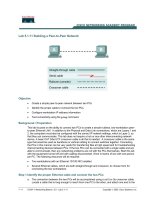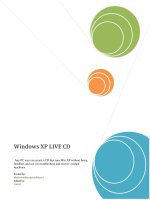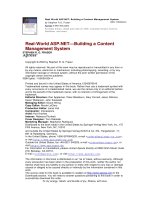Building a storybrand
Bạn đang xem bản rút gọn của tài liệu. Xem và tải ngay bản đầy đủ của tài liệu tại đây (1.48 MB, 174 trang )
PRAISEFORBUILDINGASTORYBRAND
“This is a seminal book built around an idea that will clarify, energize, and
transformyourbusiness.DonaldMilleroffersaspecific,detailed,anduseful
waytochangethewayyoutalkabouttheworkyoucareabout.”
—SETHGODIN,AUTHOROFALLMARKETERSARELIARS
“DonaldMilleroughttobeworkingwithyourcompanyjustlikeheworked
with ours. We changed our website after learning his framework and the
results were fantastic. We noticed a difference right away. The StoryBrand
Framework works—and we are implementing it companywide. Read this
book!”
—KENBLANCHARD,CHIEFSPIRITUALOFFICEROFTHEKENBLANCHARD
COMPANIESANDCOAUTHOROFTHENEWONEMINUTEMANAGER®
“DonaldMillerwillteachyoualotmorethanhowtosellproducts;hewill
teachyouhowtotransformthelivesofyourcustomers.Yourcustomersneed
youtoplayaroleintheirlives,andthisbookwillteachyouhow.Ifyouwant
yourbusinesstogrow,readthisbook.”
—JOHNC.MAXWELL,#1NEWYORKTIMESBESTSELLINGAUTHOR
“This is the most important business/marketing book of the year. All
communicators know the power of Story. Donald Miller has captured the
processtomakeyourmarketingpiercethewhitenoiseofthemostoverserved
marketinggenerationinhistory.Youhavetoreadthisbook!”
—DAVERAMSEY,#1NEWYORKTIMESBESTSELLINGAUTHOR
“Donald Miller reminds us that all good messaging begins and ends with
empathy. He knows that if you want to be seen, heard, and understood, the
first step is to listen. Get this book if you want to connect with people in a
profoundway.”
—BILLHASLAM,FORTY-NINTHGOVERNOROFTENNESSEE
“Ifyoulikemakingmoney,readthisbook.TheStoryBrandFrameworkwill
helpyoucreatesalesmessagesthatpeoplelistenandrespondto.Weuseitall
thetimeanditworks!”
—RYANDEISS,FOUNDERANDCEOOFDIGITALMARKETER
“InonlyafewhoursthisbookdemystifiedlessonsaboutbrandingthatI’ve
spent my entire career trying to understand. The brilliant StoryBrand
Framework has now become the playbook for everything we do that is
marketing-related.”
—RORYVADEN,COFOUNDEROFSOUTHWESTERNCONSULTINGANDNEW
YORKTIMESBESTSELLINGAUTHOROFTAKETHESTAIRS
“I’ve been using Don Miller’s StoryBrand framework in my business for a
fewyearsnow.It’sthesinglebestmarketingtoolIknow.Weuseitonevery
product we launch. I’ve had Don personally teach my company and clients
andIrecommendhimtoeveryone.Now,alltheserevolutionaryinsightsare
easilyaccessiblebetweenthesecovers.”
—MICHAELHYATT,NEWYORKTIMESBESTSELLINGAUTHOROFPLATFORM:
GETNOTICEDINANOISYWORLD
OceanofPDF.com
OceanofPDF.com
©2017byDonaldMiller
Allrightsreserved.Noportionofthisbookmaybereproduced,storedina
retrievalsystem,ortransmittedinanyformorbyanymeans—electronic,
mechanical,photocopy,recording,scanning,orother—exceptforbrief
quotationsincriticalreviewsorarticles,withoutthepriorwrittenpermission
ofthepublisher.
PublishedbyHarperCollinsLeadership,animprintofHarperCollins.
TheauthorisrepresentedbyAmbassadorLiteraryAgency,Nashville,TN.
GraphicsdesignedbyKyleReid.
EpubEditionSeptember2017ISBN9780718033330
ISBN978-0-7180-3333-0(eBook)
ISBN978-1-4002-0183-9(IE)
LibraryofCongressControlNumber:2017937432
ISBN978-0-7180-3332-3
PrintedintheUnitedStatesofAmerica
1718192021LSC10987654321
OceanofPDF.com
InformationaboutExternalHyperlinksinthisebook
Please note that footnotes in this ebook may contain hyperlinks to external
websites as part of bibliographic citations. These hyperlinks have not been
activated by the publisher, who cannot verify the accuracy of these links
beyondthedateofpublication.
OceanofPDF.com
Thisbookisdedicatedto:
TimSchurrerandKyleReid
forbelievingintheframeworkfromthebeginning.
WhatIlovemostaboutStoryBrandisit
allowedustobecomefriends.
Andalso:
BetsyMiller
AveryCsorba
KoulaCallahan
JJPeterson
ChadSnavely
SuzanneNorman
Youarelivingproofthatwhenagroupoffriendssacrifice
togetherforacommongood,theycanbecomefamily.
OceanofPDF.com
CONTENTS
Introduction
SECTION1:WHYMOSTMARKETINGISAMONEYPIT
1.TheKeytoBeingSeen,Heard,andUnderstood
2.TheSecretWeaponThatWillGrowYourBusiness
3.TheSimpleSB7Framework
SECTION2:BUILDINGYOURSTORYBRAND
4.ACharacter
5.HasaProblem
6.AndMeetsaGuide
7.WhoGivesThemaPlan
8.AndCallsThemtoAction
9.ThatHelpsThemAvoidFailure
10.AndEndsinaSuccess
11. People Want Your Brand to Participate in Their
Transformation
SECTION
3:
BRANDSCRIPT
IMPLEMENTING
YOUR
STORYBRAND
12.BuildingaBetterWebsite
13.UsingStoryBrandtoTransformCompanyCulture
TheStoryBrandMarketingRoadmap
Afterword
Acknowledgments
PraisefortheStoryBrandFramework
StoryBrandResources
Notes
OceanofPDF.com
INTRODUCTION
Thisisnotabookabouttellingyourcompany’sstory.Abooklikethatwould
beawasteoftime.Customersdon’tgenerallycareaboutyourstory;theycare
abouttheirown.
Yourcustomershouldbetheheroofthestory,notyourbrand.Thisisthe
secreteveryphenomenallysuccessfulbusinessunderstands.
Whatfollowsisaseven-partframeworkthatwillchangethewayyoutalk
aboutyourbusinessandperhapsthewayyoudobusiness.
Each year we help more than three thousand businesses stop wasting
moneyonmarketingandgettheircompanygrowingbyhelpingthemclarify
theirmessage.Thisframeworkwillworkforyou,regardlessofyourindustry.
Togetthemostoutofthisbook,Iencourageyoutodothreethings:
1. ReadthebookandunderstandtheSB7Framework.
2. Filteryourmessagethroughtheframework.
3. Clarifyyourmessagesomorecustomerslisten.
Marketing has changed. Businesses that invite their customers into a
heroicstorygrow.Businessesthatdon’tareforgotten.
May we all be richly rewarded for putting our customers’ stories above
ourown.
OceanofPDF.com
SECTION1
WHYMOSTMARKETINGISAMONEY
PIT
OceanofPDF.com
CHAPTER1
THEKEYTOBEINGSEEN,HEARD,AND
UNDERSTOOD
Most companies waste enormous amounts of money on marketing. We all
knowhowmind-numbingitistospendpreciousdollarsonanewmarketing
effort that gets no results. When we see the reports, we wonder what went
wrong,orworse,whetherourproductisreallyasgoodaswethoughtitwas.
Butwhatiftheproblemwasn’ttheproduct?Whatiftheproblemwasthe
waywetalkedabouttheproduct?
Theproblemissimple.Thegraphicartistsanddesignerswe’rehiringto
buildourwebsitesandbrochureshavedegreesindesignandknoweverything
about Photoshop, but how many of them have read a single book about
writing good sales copy? How many of them know how to clarify your
message so customers listen? And worse, these companies are glad to take
yourmoney,regardlessofwhetheryouseeresultsornot.
Thefactis,prettywebsitesdon’tsellthings.Wordssellthings.Andifwe
haven’tclarifiedourmessage,ourcustomerswon’tlisten.
If we pay a lot of money to a design agency without first clarifying our
message,wemightaswellbeholdingabullhornuptoamonkey.Theonly
thingapotentialcustomerwillhearisnoise.
Still,clarifyingourmessageisn’teasy.Ihadoneclientsaythatwhenhe
triedtodoso,hefeltlikehewasinsidethebottletryingtoreadthelabel.I
understand.BeforeIstartedStoryBrandIwasawriterandspentthousandsof
hoursstaringatablankcomputerscreen,wonderingwhattosay.Thatsoulwrenchingfrustrationledmetocreatea“communicationframework”based
on the proven power of story, and I swear it was like discovering a secret
formula.ThewritinggoteasierandIsoldmillionsofbooks.Afterusingthe
framework to create clear messages in my books, I used it to filter the
marketing collateral in my own small company. Once we got clear, we
doubledinrevenueforfourconsecutiveyears.Inowteachthatframeworkto
morethanthreethousandbusinesseseachyear.
Oncetheygettheirmessagestraight,ourclientscreatequalitywebsites,
incrediblekeynotes,e-mailsthatgetopened,andsalesletterspeoplerespond
to. Why? Because nobody will listen to you if your message isn’t clear, no
matterhowexpensiveyourmarketingmaterialmaybe.
AtStoryBrandwe’vehadclientsdouble,triple,andevenquadrupletheir
revenueaftertheygotonethingstraight—theirmessage.
The StoryBrand Framework has been just as effective for billion-dollar
brands as it has for mom-and-pop businesses, and just as powerful for
AmericancorporationsasithasforthoseinJapanandAfrica.Why?Because
thehumanbrain,nomatterwhatregionoftheworlditcomesfrom,isdrawn
towardclarityandawayfromconfusion.
Therealityiswearen’tjustinaracetogetourproductstomarket;we’re
alsoinaracetocommunicatewhyourcustomersneedthoseproductsintheir
lives. Even if we have the best product in the marketplace, we’ll lose to an
inferiorproductifourcompetitor’sofferiscommunicatedmoreclearly.
Sowhat’syourmessage?Canyousayiteasily?Isitsimple,relevant,and
repeatable? Can your entire team repeat your company’s message in such a
waythatitiscompelling?Havenewhiresbeengiventalkingpointstheycan
use to describe what the company offers and why every potential customer
shouldbuyit?
Howmanysalesarewemissingoutonbecausecustomerscan’tfigureout
whatourofferiswithinfivesecondsofvisitingourwebsite?
WHYSOMANYBUSINESSESFAIL
Tofindoutwhysomanymarketingandbrandingattemptsfail,Icalledmy
friendMikeMcHargue.Mike,oftencalled“ScienceMike”becausehehostsa
successfulpodcastcalledAskScienceMike,spentfifteenyearsusingsciencebasedmethodologiestohelpcompaniesfigureouthowtheircustomersthink,
specifically in the tech space. Sadly, he left advertising when a client asked
himtocreateanalgorithmpredictingtheassociatedbuyinghabitsofpeople
with diabetes. Translation: they wanted him to sell junk food to diabetics.
Mikerefusedandlefttheindustry.He’sagoodman.Icalled,though,because
he still has incredible insight as to how marketing, story, and behavior all
blendtogether.
At my request, Mike flew to Nashville to attend one of our workshops.
After two days learning the StoryBrand 7-Part Framework (hereafter called
the SB7 Framework), we sat on my back porch and I grilled him with
questions. Why does this formula work? What’s happening in the brains of
consumersastheyencounteramessagefilteredthroughthisformula?What’s
thesciencebehindwhybrandslikeAppleandCoke,whointuitivelyusethis
formula,dominatethemarketplace?
“There’s a reason most marketing collateral doesn’t work,” Mike said,
puttinghisfeetuponthecoffeetable.“Theirmarketingistoocomplicated.
Thebraindoesn’tknowhowtoprocesstheinformation.Themoresimpleand
predictable the communication, the easier it is for the brain to digest. Story
helpsbecauseitisasense-makingmechanism.Essentially,storyformulasput
everything in order so the brain doesn’t have to work to understand what’s
goingon.”
Mikewentontoexplainthatamongthemillionthingsthebrainisgood
at, the overriding function of the brain is to help an individual survive and
thrive.Everythingthehumanbraindoes,allday,involveshelpingthatperson,
andthepeoplethatpersoncaresabout,getaheadinlife.
Mike asked if I remembered that old pyramid we learned about in high
school, Abraham Maslow’s hierarchy of needs. First, he reminded me, the
brain is tasked with setting up a system in which we can eat and drink and
survivephysically.Inourmodern,first-worldeconomythismeanshavinga
jobandadependableincome.Thenthebrainisconcernedwithsafety,which
might entail having a roof over our heads and a sense of well-being and
powerthatkeepsusfrombeingvulnerable.Afterfoodandshelteraretaken
care of, our brains start thinking about our relationships, which entail
everything from reproducing in a sexual relationship, to being nurtured in a
romanticrelationship,tocreatingfriendships(atribe)whowillstickbyusin
case there are any social threats. Finally then, the brain begins to concern
itself with greater psychological, physiological, or even spiritual needs that
giveusasenseofmeaning.
What Mike helped me understand is that, without us knowing it, human
beings are constantly scanning their environment (even advertising) for
information that is going to help them meet their primitive need to survive.
Thismeansthatwhenwerambleonandonabouthowwehavethebiggest
manufacturing plant on the West Coast, our customers don’t care. Why?
Because that information isn’t helping them eat, drink, find a mate, fall in
love, build a tribe, experience a deeper sense of meaning, or stockpile
weaponsincasebarbariansstartcomingoverthehillbehindourcul-de-sac.
Sowhatdocustomersdowhenweblastabunchofnoiseatthem?They
ignoreus.
Andsorightthereonmybackporch,Mikedefinedtwocriticalmistakes
brandsmakewhentheytalkabouttheirproductsandservices.
MistakeNumberOne
Thefirstmistakebrandsmakeistheyfailtofocusontheaspectsoftheir
offerthatwillhelppeoplesurviveandthrive.
Allgreatstoriesareaboutsurvival—eitherphysical,emotional,relational,
orspiritual.Astoryaboutanythingelsewon’tworktocaptivateanaudience.
Nobody’sinterested.Thismeansthatifwepositionourproductsandservices
as anything but an aid in helping people survive, thrive, be accepted, find
love, achieve an aspirational identity, or bond with a tribe that will defend
them physically and socially, good luck selling anything to anybody. These
aretheonlythingspeoplecareabout.Wecantakethattruthtothebank.Orto
bankruptcycourt,shouldwechoosetoignoreitasanundeniablefact.
Mikesaidourbrainsareconstantlysortingthroughinformationandsowe
discardmillionsofunnecessaryfactseveryday.Ifweweretospendanhour
inagiantballroom,ourbrainswouldneverthinktocounthowmanychairs
are in the room. Meanwhile, we would always know where the exits are.
Why?Becauseourbrainsdon’tneedtoknowhowmanychairstherearein
theroomtosurvive,butknowingwheretheexitsarewouldbehelpfulincase
therewasafire.
Without knowing it, the subconscious is always categorizing and
organizing information, and when we talk publicly about our company’s
randombackstoryorinternalgoals,we’repositioningourselvesasthechairs,
nottheexits.
“But this poses a problem,” Mike continued. “Processing information
demands that the brain burn calories. And the burning of too many calories
actsagainstthebrain’sprimaryjob:tohelpussurviveandthrive.”
MistakeNumberTwo
Thesecondmistakebrandsmakeistheycausetheircustomerstoburntoo
manycaloriesinanefforttounderstandtheiroffer.
Whenhavingtoprocesstoomuchseeminglyrandominformation,people
begintoignorethesourceofthatuselessinformationinanefforttoconserve
calories.Inotherwords,there’sasurvivalmechanismwithinourcustomers’
brainthatisdesignedtotuneusoutshouldweeverstartconfusingthem.
Imagine every time we talk about our products to potential customers,
theyhavetostartrunningonatreadmill.Literally,theyhavetojogthewhole
time we’re talking. How long do you think they’re going to pay attention?
Not long. And yet this is precisely what’s happening. When we start our
elevator pitch or keynote address, or when somebody visits our website,
they’reburningcaloriestoprocesstheinformationwe’resharing.Andifwe
don’tsaysomething(andsaysomethingquickly)theycanusetosurviveor
thrive,theywilltuneusout.
Thesetworealities—therealitythatpeoplearelookingforbrandsthatcan
help them survive and thrive, and the reality that communication must be
simple—explain why the SB7 Framework has helped so many businesses
increase their revenue. The key is to make your company’s message about
something that helps the customer survive and to do so in such a way that
theycanunderstanditwithoutburningtoomanycalories.
STORYTOTHERESCUE
Mike agreed the most powerful tool we can use to organize information so
peopledon’thavetoburnverymanycaloriesisstory.Ashesaid,storyisa
sense-making device. It identifies a necessary ambition, defines challenges
thatarebattlingtokeepusfromachievingthatambition,andprovidesaplan
tohelpusconquerthosechallenges.Whenwedefinetheelementsofastory
asitrelatestoourbrand,wecreateamapcustomerscanfollowtoengageour
productsandservices.
Still,whenItalkaboutstorytobusinessleaders,theyimmediatelyputme
in a category with artists, thinking I want to introduce them to something
fanciful.Butthat’snotwhatI’mtalkingabout.I’mtalkingaboutaconcrete
formulawecanusetogarnerattentionfromotherwisedistractedcustomers.
I’mtalkingaboutpracticalstepswecantaketomakesurepeopleseeus,hear
us,andunderstandexactlywhytheysimplymustengageourproducts.
THEFORMULAFORCLEARCOMMUNICATION
Formulasaresimplythesummationofbestpractices,andthereasonwelike
them is because they work. We’ve been given great management formulas
like Ken Blanchard’s Situational Leadership and formulas we can use in
manufacturing like Six Sigma and Lean Manufacturing. But what about a
formula for communication? Why don’t we have a formula we can use to
effectivelyexplainwhatourcompanyofferstheworld?
The StoryBrand Framework is that formula. We know it works because
some form of this formula has been active for thousands of years to help
peopletellstories.Talkaboutasummationofbestpractices.Whenitcomes
to getting people to pay attention, this formula will be your most powerful
ally.
Once you know the formulas, you can predict the path most stories will
take.I’velearnedtheseformulassowellthatmywifehatesgoingtomovies
withmebecausesheknowsatsomepointI’mgoingtoelbowherandwhisper
somethinglike,“Thatguy’sgoingtodieinthirty-oneminutes.”
Story formulas reveal a well-worn path in the human brain, and if we
wanttostayinbusiness,weneedtopositionourproductsalongthispath.
If you’re going to continue reading this book, I have to warn you, I’m
going to ruin movies for you. I mean, these things really are formulaic.
They’re predictable. And they’re predictable for a reason. Storytellers have
figuredouthowtokeepanaudience’sattentionforhours.
The good news is these formulas work just as well at growing your
businessastheydoatentertaininganaudience.
THEKEYISCLARITY
The narrative coming out of a company (and for that matter inside a
company)mustbeclear.Inastory,audiencesmustalwaysknowwhothehero
is, what the hero wants, who the hero has to defeat to get what they want,
what tragic thing will happen if the hero doesn’t win, and what wonderful
thing will happen if they do. If an audience can’t answer these basic
questions,they’llcheckoutandthemoviewilllosemillionsattheboxoffice.
Ifascreenwriterbreakstheserules,they’lllikelyneverworkagain.
The same is true for the brand you represent. Our customers have
questions burning inside them, and if we aren’t answering those questions,
they’llmoveontoanotherbrand.Ifwehaven’tidentifiedwhatourcustomer
wants,whatproblemwearehelpingthemsolve,andwhatlifewilllooklike
aftertheyengageourproductsandservices,forexample,wecanforgetabout
thrivingin the marketplace. Whether we’re writing a story or attempting to
sellproducts,ourmessagemustbeclear.Always.
Infact,atStoryBrandwehaveamantra:“Ifyouconfuse,you’lllose.”
BUSINESSHASANENEMY
Business has a fierce, insidious enemy that, if not identified and combated,
will contort our company into an unrecognizable mess. The enemy I’m
talkingaboutisnoise.
Noisehaskilledmoreideas,products,andservicesthantaxes,recessions,
lawsuits, climbing interest rates, and even inferior product design. I’m not
talking about the noise inside our business; I’m talking about the noise we
create as a business. What we often call marketing is really just clutter and
confusion sprayed all over our websites, e-mails, and commercials. And it’s
costingusmillions.
Yearsago,aStoryBrandclientwhoattendedoneofourworkshopspushed
back. “I don’t think this will work for me,” he said. “My business is too
diversetoreducedowntoasimplemessage.”Iaskedhimtoexplain.
“I have an industrial painting company with three different revenue
streams. In one division we powder-coat auto parts. In another we apply
sealanttoconcrete,andinanotherwehaveasterilizedpaintingprocessused
specificallyinhospitals.”
His business was diverse, but nothing so complex that it couldn’t be
simplifiedsomorepeoplewouldhirehim.IaskedifIcouldputhiswebsite
onthegianttelevisionscreensotheentireworkshopcouldseeit.Hiswebsite
was thoughtful, but it didn’t make a great deal of sense from an outside
perspective(whichishoweverycustomerviewsyourbusiness).
Themanhadhiredafine-artspaintertocreateapaintingofhisbuilding
(washesellingabuilding?),andatfirstglanceitlookedlikethewebsitefor
anItalianrestaurant.ThefirstquestionIhadwhenIwenttothewebsitewas,
“Doyouservefreebreadsticks?”Therewereathousandlinksrangingfrom
contact information to FAQs to a timeline of the company’s history. There
wereevenlinkstothenonprofitsthebusinesssupported.Itwasasthoughhe
wasansweringahundredquestionshiscustomershadneverasked.
I asked the class to raise their hands if they thought his business would
growifwewipedthewebsitecleanandsimplyfeaturedanimageofaguyin
a white lab coat painting something next to text that read, “We Paint All
KindsofS#*%,”accompaniedbyabuttoninthemiddleofthepagethatsaid,
“GetaQuote.”
Theentireclassraisedtheirhands.
Of course his business would grow. Why? Because he’d finally stopped
forcing clients to burn calories thinking about his life and business and
offeredtheonethingthatwouldsolvehiscustomers’problem:apainter.
What we think we are saying to our customers and what our customers
actuallyheararetwodifferentthings.Andcustomersmakebuyingdecisions
notbasedonwhatwesaybutonwhattheyhear.
STOPSAYINGTHAT
Allexperiencedwritersknowthekeytogreatwritingisn’tinwhattheysay;
it’sinwhattheydon’tsay.Themorewecutout,thebetterthescreenplayor
book.ThemathematicianandphilosopherBlaisePascalisoftencreditedfor
sendingalongletterstatinghesimplydidn’thavetimetosendashortone.
Ifwewanttoconnectwithcustomers,wehavetostopblastingthemwith
noise.
The beautiful thing about clarifying our message using the SB7
Frameworkisitmakescommunicatingeasy.Nolongerwillyousitinfrontof
ablankpagewonderingwhattosayonyourwebsite,inyourelevatorpitch,
inyoure-mailblast,inyourFacebookads,orevenonyourtelevisionorradio
commercials.
CLARIFYYOURMESSAGE
Whether we run a small company or a multibillion-dollar brand, confusing
our customers is costing us money. How many of our team members can’t
explainhowwehelpourcustomerssurviveandthrive?Howmanypeopleare
buying from our competition because they’ve communicated more clearly
thanwehave?Howlongwillwelastifwekeeptalkingaboutaspectsofour
productsourcustomersdon’tcareabout?
Thingscanbedifferent.
Toclarifyourmessagewe’regoingtoneedaformula.Aseriousformula.
This formula needs to organize our thinking, reduce our marketing effort,
obliterate confusion, terrify the competition, and finally get our businesses
growingagain.
Let’slearnaboutthatformulanow.
OceanofPDF.com
CHAPTER2
THESECRETWEAPONTHATWILL
GROWYOURBUSINESS
Tohelpyougrowyourcompany,I’mgoingtoguideyouinsimplifyingyour
message into soundbites that come from seven categories. Once you have
these seven messages down, any anxiety you experience talking about your
brandwillsubsideandcustomerswillbemoreattractedtowhatyouoffer.We
aregoingtofigureoutyourcustomers’storyandplaceourselvesrightsmack
inthemiddleofit.
Storyisatomic.Itisperpetualenergyandcanpoweracity.Storyisthe
onethingthatcanholdahumanbeing’sattentionforhours.
Nobody can look away from a good story. In fact, neuroscientists claim
the average human being spends more than 30 percent of their time
daydreaming . . . unless they’re reading, listening to, or watching a story
unfold. Why? Because when we are engaged in a story, the story does the
daydreamingforus.
Story is the greatest weapon we have to combat noise, because it
organizesinformationinsuchawaythatpeoplearecompelledtolisten.
STORYMAKESMUSICOUTOFNOISE
Living in Nashville I’ve learned quite a bit about the difference between
music and noise. Nearly half our friends here are musicians. I’m always
amazed at their talent. Hardly a dinner party goes by without somebody
grabbingaguitar.
IcouldsummarizewhatI’velearnedaboutthedifferencebetweenmusic
and noise by saying my friends make music and I make noise, but there’s
actuallysomecomplicatedscienceinvolved.
Technically speaking, music and noise are similar. Both are created by
travelingsoundwavesthatrattleoureardrums.Music,however,isnoisethat
has been submitted to certain rules that allow the brain to engage on a
differentlevel.IfIplayedyouarecordingofadumptruckbackingup,birds
chirping, and children laughing, you’d not remember those sounds the next
day. But if I played you a Beatles song, you’d likely be humming it for a
week.
There is an obvious difference between a well-choreographed piece of
music and the sound of a cat chasing a rat through a wind-chime factory,
whichistheequivalentoftheaveragecorporatewebsite,keynotespeech,or
elevatorpitch.
The brain remembers music and forgets about noise just like the brain
rememberssomebrandsandforgetsaboutothers.
Storyissimilartomusic.Agoodstorytakesaseriesofrandomeventsand
distillsthemintotheessenceofwhatreallymatters.There’sareasonthefinal
cutofamovieiscalledafinalcut.Priortothetheatricalversion,afilmhas
gone through rounds upon rounds of edits, omissions, revisions, and
deletions. Sometimes entire characters end up on the cutting-room floor.
Why?Becausestorytellershavefilterstocutoutthenoise.Ifacharacteror
scenedoesn’tservetheplot,ithastogo.
When clients want to add a bunch of confusion to their marketing
message, I ask them to consider the ramifications of doing so if they were
writingascreenplay.Imean,whatifTheBourneIdentitywereamovieabout
aspynamedJasonBournesearchingforhistrueidentitybutitalsoincluded
scenesofBournetryingtoloseweight,marryagirl,passthebarexam,win
on Jeopardy, and adopt a cat? The audience would lose interest. When
storytellers bombard people with too much information, the audience is
forced to burn too many calories organizing the data. As a result, they
daydream,walkoutofthetheater,orinthecaseofdigitalmarketing,clickto
anothersitewithoutplacinganorder.
Whydosomanybrandscreatenoiseratherthanmusic?It’sbecausethey
don’trealizetheyarecreatingnoise.Theyactuallythinkpeopleareinterested
intherandominformationthey’redolingout.
Thisiswhyweneedafilter.Theessenceofbrandingistocreatesimple,
relevantmessageswecanrepeatoverandoversothatwe“brand”ourselves
intothepublicconsciousness.
STEVEJOBSANDTHEMESSAGEOFAPPLE
Apple grew much larger only after Steve Jobs began filtering his message
through the lens of story. Transformation in his thinking happened after
working with (and partially creating) the genius storytelling factory that is
Pixar.WhenJobscamebacktoAppleafterbeingsurroundedbyprofessional
storytellers,herealizedstorywaseverything.
Just think about the incredible transformation that took place in Steve’s
lifeandcareerafterPixar.In1983,ApplelaunchedtheircomputerLisa,the
last project Jobs worked on before he was let go. Jobs released Lisa with a
nine-page ad in the New York Times spelling out the computer’s technical
features.ItwasninepagesofgeektalknobodyoutsideNASAwasinterested
in.Thecomputerbombed.
When Jobs returned to the company after running Pixar, Apple became
customer-centric, compelling, and clear in their communication. The first
campaignhereleasedwentfromninepagesintheNewYorkTimestojusttwo
wordsonbillboardsalloverAmerica:ThinkDifferent.
When Apple began filtering their communication to make it simple and
relevant, they actually stopped featuring computers in most of their
advertising. Instead, they understood their customers were all living,
breathing heroes, and they tapped into their stories. They did this by (1)
identifyingwhattheircustomerswanted(tobeseenandheard),(2)defining
theircustomers’challenge(thatpeopledidn’trecognizetheirhiddengenius),
and(3)offeringtheircustomersatooltheycouldusetoexpressthemselves
(computersandsmartphones).Eachoftheserealizationsarepillarsinancient
storytellingandcriticalforconnectingwithcustomers.
I’llteachyouaboutthesethreepillarsandmoreinthecomingchapters,
butfornowjustrealizethetimeApplespentclarifyingtheroletheyplayin
their customers’ story is one of the primary factors responsible for their
growth.
Notice, though, the story of Apple isn’t about Apple; it’s about you.
You’re the hero in the story, and they play a role more like Q in the James
Bondmovies.Theyaretheguyyougoseewhenyouneedatooltohelpyou
wintheday.
Despite what acolytes of the cult of Mac may say, Apple likely doesn’t
makethebestcomputersorphones.“Best”issubjective,ofcourse.Whether
Applehasthebesttechnology,though,isdebatable.
But it doesn’t matter. People don’t buy the best products; they buy the
productstheycanunderstandthefastest.Applehasinsertedthemselvesinto
their customers’ story like no other technology company, and as a result,
they’renotonlythelargesttechnologycompany,they’reinthetoptenlargest
companiesperiod.1 If we want our companies to grow, we should borrow a
pagefromtheirplaybook.Weshouldclarifyourmessage.
STORYCANGROWYOURBUSINESS
To better understand what Steve Jobs learned during his days at Pixar, let’s
take off our business hats for a few pages and pretend we’re learning about
storyforthefirsttime.Onceyouunderstandhowstoryintegrateswithyour
brand message, you’ll be able to create communication pieces (and even a
brandstrategy)thatengagesmorecustomersandgrowsyourbusiness.Andif
you really get this down, people around the office will wonder how in the
worldyoubecamesuchamarketinggenius.
After studying hundreds of movies, novels, plays, and musicals across
nearly every imaginable genre, and after having written eight books of my
own along with a nationally released screenplay, I’ve narrowed down the
necessary elements of a compelling story to seven basic plot points. If we
werewritingafullscreenplay,ofcourse,we’dneedmore,butforpurposesof
understandingandenteringintoourcustomers’story,thereareonlyseven.
StoryinaNutshell
Hereisnearlyeverystoryyouseeorhearinanutshell:ACHARACTER
whowantssomethingencountersaPROBLEMbeforetheycangetit.Atthe
peakoftheirdespair,aGUIDEstepsintotheirlives,givesthemaPLAN,and
CALLS THEM TO ACTION. That action helps them avoid FAILURE and
endsinaSUCCESS.
That’s really it. You’ll see some form of this structure in nearly every
movie you watch from here on out. These seven basic plot points are like
chordsofmusicinthesensethatyoucanusethemtocreateaninfinitevariety
ofnarrativeexpression.Justlikeplayingtheguitar,withthesesevenchords
you can create any number of songs. Varying too far from these chords,
however,meansyouriskdescendingintonoise.
Let’slookathowthissimpleframeworkplaysoutinacoupleoffamiliar
stories. Once you can recognize the framework in stories, you’ll start to
understandexactlywherethestoryofyourbrandisconfusingcustomersby
notstickingtotheformula.
In the first HungerGames movie, Katniss Everdeen must compete in a
twistedfight-to-the-deathtournamentforceduponthepeopleofPanembyan
evil, tyrannical government called the Capitol. The problem she faces is
obvious: she must kill or be killed. Katniss is overwhelmed, underprepared,
andoutnumbered.
Along comes Haymitch, the brash, liquor-loving, grizzled winner of a
previousHungerGamestournament.HaymitchassumestheroleofKatniss’s
mentor, helping her hatch a plan to win over the public. This gains Katniss
more sponsors, thereby equipping her with more resources for the fight and
increasingherchancesofwinning.
HereisthefirstHungerGamesstorylaidoutontheStoryBrandgrid:
In Star Wars: A New Hope, our reluctant hero, Luke Skywalker,
experiences a devastating tragedy: his aunt and uncle are murdered at the
handsoftheevilEmpire.Thissetsaseriesofeventsinmotion:Lukebegins
the journey of becoming a Jedi Knight and destroys the Empire’s battle
station,theDeathStar,whichallowstheRebelliontoliveandfightanother
day.Enteraguide,Obi-WanKenobi,aformerJediKnightwhooncetrained
Luke’sfather.
Not every story works this way, but most do. Sometimes a writer will
bringinmultipleguidesor(usuallytothestory’speril)leavetheguideout,
buttheformulaholdsupinalmosteverystoryyou’llencounter.
Thefactthatnearlyeverymovieyougoseeatthetheaterincludesthese
seven elements means something. After thousands of years, storytellers the
worldoverhavearrivedatthisformulaasameansofbestpractices.Simply
put, this framework is the pinnacle of narrative communication. The further
weveerawayfromthesesevenelements,theharderitbecomesforaudiences
to engage. This is why indie films, which often break from the formula to
gain critical acclaim, fail miserably at the box office. Critics are hungry for
somethingdifferent,yetthemasses,whodonotstudymoviesprofessionally,
simplywantaccessiblestories.
Itseemstruethatsomebrands(aswellassomescreenwriters)breakthese
formulasandsucceedallthesame,butwhenyoulookclosely,thisisrarely
thecase.Trulycreativeandbrilliantmarketersandscreenwritersknowhowto
use the formula while still avoiding cliché. This, in my opinion, is what
makes them brilliant. When you get good at the SB7 Framework, hardly
anybodywillnoticeyouareusingit.
TheThreeCrucialQuestions
Sohowdowemakethestoryourcompanyistellingclear?
Remember,thegreatestenemyourbusinessfacesisthesameenemythat









